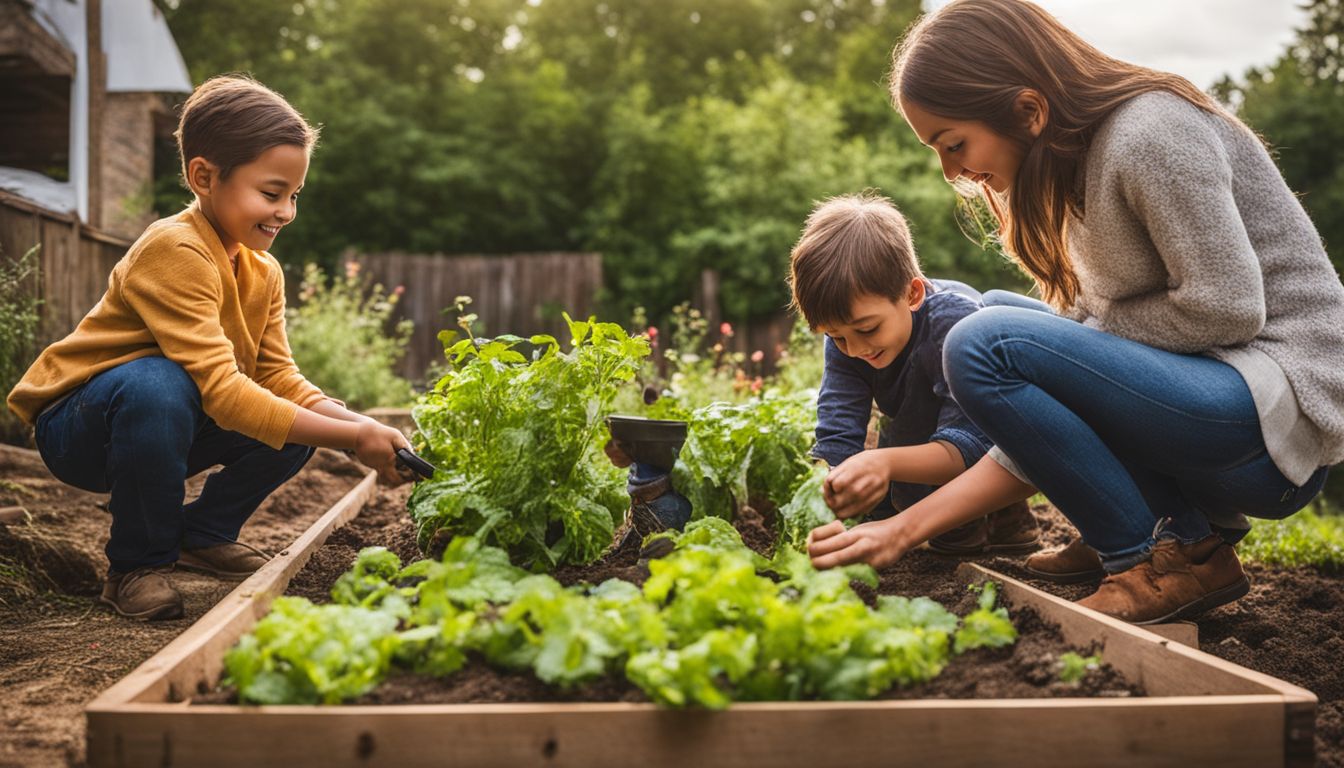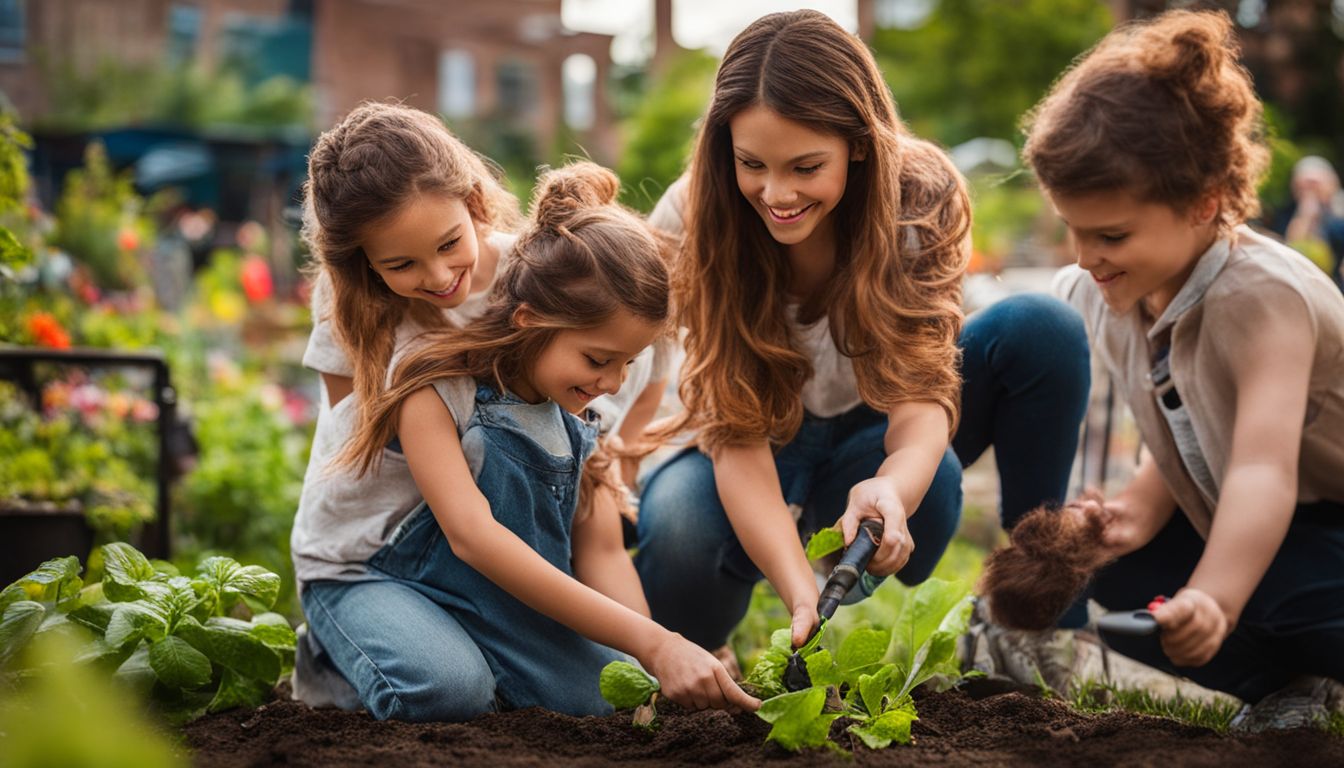
By: GreenFrontier Dispatch
Sustainable Living Meaning: Your Ultimate Guide to Eco-Friendly Living
Many people think living eco-friendly is hard. But, here’s a fact: adopting sustainable habits can dramatically reduce the pressure on our planet. This guide breaks down what it means to live sustainably, offering simple yet impactful ways to make a difference.
With climate change knocking at our door, understanding and practicing sustainable living isn’t just good—it’s necessary.
I bring over two decades of experience in designing homes that respect nature while using the latest technology. My work has not only won awards but also helped many understand how small changes can lead to significant impacts.
Ready for a journey into eco-friendly living? Let’s explore how you can do your part easily and effectively.
Key Takeaways
- Sustainable living helps us use less, cut down waste, and protect the Earth for future people. It includes saving water, recycling, using solar power, and buying local foods.
- Water is important to save. We can do this by fixing leaks and using low – flow showerheads. Buying food from local farmers cuts down on pollution from transport.
- Eating organic foods supports farmers who don’t use harmful chemicals. Composting turns our food waste into rich soil instead of it becoming trash in landfills.
- Green building methods make houses that are good for the planet. Cities that follow LEED standards have healthier spaces for people to live.
- Jobs like environmental compliance specialists and sustainability managers help companies be kinder to the environment. They look at how businesses operate and find ways to reduce harm to the planet.
Defining Sustainable Living
 Sustainable living means making choices today that help the earth tomorrow. It’s about using less and being smart with what we have. This way of life tries to lower pollution, waste, and our carbon footprint to protect the planet for future generations.
Sustainable living means making choices today that help the earth tomorrow. It’s about using less and being smart with what we have. This way of life tries to lower pollution, waste, and our carbon footprint to protect the planet for future generations.
People live sustainably by saving water, choosing reusable products over single-use items, and favoring public transportation or bikes over cars.
Sustainable living is not just an idea; it’s a necessary path for protecting our planet.
Principles like environmental preservation guide us toward caring for natural resources. The goal is to balance how we meet our needs without hurting future people’s chances to meet theirs.
Living this way involves easy changes like recycling, composting food waste, and supporting renewable energy sources such as solar or wind power. These actions are simple but powerful ways to make a big impact on the environment.
The Importance of Sustainable Living

Living sustainably has big benefits for our health and the Earth. It makes life better by reducing pollution from cars, encouraging us to eat healthier foods, and cutting down on waste.
This way of living uses less energy, conserves water, and limits harmful gases that warm the planet. By choosing a sustainable lifestyle, people can help keep the air clean, save animals’ homes, and make sure there is enough food and water for everyone.
This green approach also supports local farmers who grow food in ways that are good for the planet. Eating organic foods cuts down on chemicals used in farming that can harm wildlife and water sources.
Composting food scraps turns them into rich soil instead of letting them rot in landfills where they release methane gas—a major pollutant. Through recycling, we use materials again instead of making more trash.
These actions lead to cleaner environments and stronger communities by using resources wisely today without harming future generations’ ability to live well.
Next up: Principles of Sustainability introduces how these ideas form a solid foundation for living green every day.
Principles of Sustainability
Understanding the importance of sustainable living leads us to explore its core principles. These are social equity, economic viability, and environmental preservation. Social equity ensures that every person has fair access to resources and opportunities.
Economic viability means activities support themselves financially without harming our planet. Environmental preservation focuses on protecting natural habitats and reducing pollution.
These three principles guide us in making choices that benefit everyone, now and in the future. They help us think about how we design homes, use energy, and consume goods. Following these rules makes our lives better while caring for the Earth.
We aim for a balance where people live well without using up all nature’s gifts or hurting the environment.
Examples of Sustainable Living Practices
Practice sustainable living by conserving water, supporting local farmers, eating organic foods, composting, and recycling. Embrace green building initiatives and LEED-certified cities for innovative sustainable living strategies.
Pursue careers as an environmental compliance specialist or sustainability manager to promote eco-friendly living practices.
Conserving Water
Conserving water is crucial for sustainable living. Using low-flow showerheads, fixing leaks, and running dishwashers and washing machines only when full can improve household water sustainability.
Upgrading to more water-efficient appliances, such as low flush toilets and high-efficiency washing machines, significantly reduces water usage. Outdoor spaces can also conserve water through drought-resistant plants and xeriscaping techniques.
“In an era of environmental responsibility, conserving water in our daily activities ensures a greener future for all.”
Supporting Local Farmers
Supporting local farmers is crucial for sustainable living. By purchasing produce from nearby farms, you reduce the environmental impact caused by long transportation distances and support a more resilient local economy.
Small-scale farming operations often employ more sustainable agricultural methods, minimizing harmful chemical use and promoting biodiversity. Additionally, buying locally and in-season reduces carbon emissions associated with long-distance shipping while ensuring fresher and more nutritious food on your table.
Local farmers utilize eco-friendly practices that contribute positively to the environment and help lower carbon output compared to large-scale industrial agriculture. Buying directly from them not only supports sustainability but also fosters a thriving community-based food system that benefits everyone involved.
Eating Organic Foods
Transitioning from supporting local farmers, another crucial aspect of sustainable living is consuming organic foods. Eating organic reduces the environmental impact of food production and distribution.
Organic farming promotes ecological management systems, which minimize the environmental impact of industrial agricultural production. By purchasing organic products, we support sustainable living and biodiversity as organic farming practices are more environmentally friendly than conventional methods.
Additionally, adopting a plant-based diet contributes to sustainable living by reducing our carbon footprint and supporting eco-friendly agricultural practices.
Organic foods reduce the use of synthetic pesticides, promote soil health, and contribute to the preservation of natural ecosystems. Moreover, they support local farmers who prioritize sustainability in their agricultural practices.
Composting
Composting is essential for sustainable living. It reduces reliance on chemical fertilizers and improves water retention in soils. By reducing organic waste sent to landfills, it also helps lower methane emissions, promoting a healthier environment.
Recycling
Recycling is a key aspect of sustainable living. It involves reusing materials like paper, glass, and plastics to reduce waste. Buying products made from recycled materials supports this practice.
For alternative house design lovers, incorporating recycled elements into construction materials and decor can significantly minimize the environmental impact of building projects.
Supporting the three Rs – reduce, reuse, recycle – in home design fosters an eco-friendly space that aligns with sustainable living principles. This integrated approach contributes to conserving resources for future generations while promoting creativity in design solutions.
Innovations in Sustainable Living
Innovations in Sustainable Living include eco-friendly building designs and LEED-certified cities, as well as initiatives like the Powerhouse Brattørkaia. Careers that promote sustainable living encompass roles such as environmental compliance specialists and sustainability managers.
Green Building Initiative
Green Building Initiative speeds up the use of eco-friendly building methods. Architects, developers, and government agencies are key targets for promoting sustainable construction.
LEED-certified cities set goals to advocate green and sustainable living. In November 2019, Atlanta became the 100th city to earn LEED certification.
This initiative is pivotal in advancing sustainable architectural practices. It encourages architects and developers to prioritize eco-conscious design when creating new buildings and renovating existing structures.
LEED-Certified Cities
LEED-Certified Cities, like Atlanta, prioritize green living and sustainability. These cities comply with LEED standards to secure healthier spaces for their citizens and the environment.
This initiative fosters eco-friendly buildings and communities that reduce energy consumption, promote renewable resources, and minimize environmental impact.
The Green Building Initiative targets architects, developers, and government agencies to foster best practices in sustainable building. With LEED-certified cities setting the pace for a greener future, alternative house design enthusiasts can draw inspiration from these innovative urban spaces to create environmentally conscious dwellings of their own.
Powerhouse Brattørkaia
Powerhouse Brattørkaia, located in Trondheim, Norway, generates more energy than it consumes. Excess energy is shared with nearby buildings and electric transit. This innovative building represents a cutting-edge approach to sustainable living, pushing the boundaries of eco-friendly architecture.
Join us as we explore remarkable concepts like Powerhouse Brattørkaia that ignite our passion for alternative house design and sustainability. Let’s delve into these transformations shaping our world!
Careers that Promote Sustainable Living
Careers in sustainable living include Environmental Compliance Specialist, Recycling Coordinator, Sustainability Manager, Urban Planner, and Environmental Planner. These roles focus on supporting eco-friendly practices to protect the environment for future generations.
Environmental Compliance Specialist
An environmental compliance specialist ensures businesses follow environmental laws and regulations, reducing their carbon footprint. They monitor and assess the impact of business activities on the environment and develop strategies to minimize negative effects.
Environmental compliance specialists also promote eco-friendly initiatives within organizations by implementing sustainable practices and educating employees on best environmental practices.
Their vital role contributes directly to promoting sustainable living while ensuring environmentally responsible operations. Businesses rely on these specialists to comply with regulations, reduce their impact on the environment, and establish a culture of sustainability within their operations.
Recycling Coordinator
A recycling coordinator plays a vital role in community education and program implementation, making it easy for people to recycle. They earn a median annual salary of $49,000. Recycling coordinators educate communities about recycling’s importance and guide them through implementing easy-to-use recycling programs.
Sustainability Manager
A Sustainability Manager oversees environmental initiatives within companies or organizations, ensuring they align with sustainable living principles. They develop and implement strategies to reduce energy use, promote recycling programs, and minimize waste.
With significant job growth expected in green occupations, there are increasing opportunities for careers such as Sustainability Managers.
They work with alternative house design companies to integrate sustainability practices into construction projects. A Sustainability Manager collaborates with architects and builders to incorporate eco-friendly materials and energy-efficient designs while adhering to sustainable living guidelines.
This career path offers a chance to contribute positively towards reducing greenhouse gas emissions and promoting environmental protection within the urban planning realm.
…
Urban Planner
Urban planners design sustainable homes, using eco-friendly methods and materials. They consider factors like location and essential services for sustainable transportation choices.
Techniques include orienting buildings east-west for passive solar lighting and heating.
To promote urban sustainability, they work on projects for sustainable water use and conservation in urban areas. Urban planning is expected to see significant job growth by 11% between 2018 and 2028.
Environmental Planner
Environmental planners are crucial in shaping sustainable urban environments. They develop strategies and blueprints that prioritize eco-friendly practices, collaborating with various stakeholders to ensure projects align with environmental goals.
Their work revolves around creating plans that support sustainable development and enhance the quality of urban life.
These professionals play a pivotal role in promoting environmentally friendly practices within city planning, striving to balance growth while safeguarding natural resources. As an alternative house design enthusiast, knowing about environmental planners can help you understand how eco-conscious decisions are integrated into urban development efforts.
Conclusion
In summary, sustainable living is the key to a healthier planet and a more fulfilling lifestyle. By embracing eco-friendly practices like conserving water, supporting local farmers, and using sustainable energy, we can all contribute to a brighter future.
Innovations in green building and careers promoting sustainability offer promising opportunities for positive change. It’s time for us to take action and make a difference in our world – one small step at a time! Let’s join hands towards creating a sustainable future for generations to come.
FAQs
1. What does sustainable living mean?
Sustainable living is all about making choices that help conserve the Earth’s resources. It means living in a way that uses less and aims to reduce our negative environmental impact, ensuring we don’t compromise the ability of future generations to meet their needs.
2. How can I start living more sustainably?
You can begin by using less water and energy, choosing sustainable farming products, reducing waste by aiming for a zero-waste lifestyle, and opting for clean energy sources like solar or wind power. It’s about finding easy ways to live more sustainably every day.
3. Are there simple changes I can make to live sustainably?
Yes! Start with small steps: turn off lights when you leave a room, use reusable bags instead of plastic ones, try walking or biking instead of driving sometimes, and support sustainable fashion brands. Every little bit helps!
4. Can sustainable living really make a difference?
Absolutely! When many people choose to live sustainably, it reduces demand for fossil fuels, cuts down millions of tons of waste from landfills each year, conserves precious water resources – all contributing significantly towards protecting our planet.
5. Is it expensive to live sustainably?
Not necessarily! Sustainable living often involves using what you have more wisely and reducing consumption—which can save money in the long run. Things like conserving energy or growing your own veggies are great examples where saving resources also means saving cash.
6. Why is it important for everyone to consider sustainable living?
Living sustainably isn’t just good for the environment; it ensures clean air and water access for communities worldwide while helping preserve natural habitats and biodiversity for future generations—it’s essential for everyone’s health and well-being.